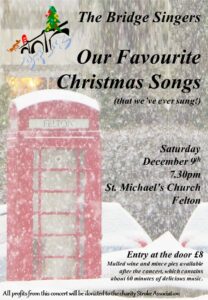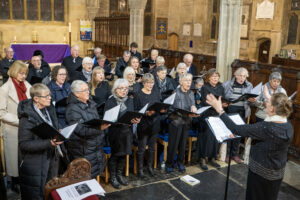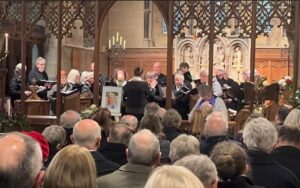The Bridge Singers’ Christmas 2023
Categories: Arrangements for choir, Life As A Composer, The Bridge Singers

After our July 2023 Night and Day concert, each member of The Bridge Singers was given five votes to entirely choose the repertoire for our 2023 Christmas Concert from every Christmas song we’d ever sung. The 70 minutes or so of music with the most votes was included in our main concert on December 9th and excerpts from the “winning” list in our other Christmas outings.
Our other Christmas outings have included a couple of performances one Sunday in late November, singing for 40 minutes each time in the King’s Hall at Bamburgh Castle, to anyone who happened to be passing. Quite a few were passing, but lots and lots of them actually stayed put and listened to our full set. We’ve never sung there before, so it was a thrilling new place for us, and an entirely different sort of audience, most of whom had no personal connection to any of us! One of the castle guides enjoyed our selection, which “was not the usual carols that everyone sings”.
The day after our main concert we once again sang at the very exhilarating setting of Brinkburn Priory for their annual Carol Service. Music selected for us to sing from our repertoire was Madre Che Festi, my The Lamb and Hodie Christus Natus Est, Berlioz’ Shepherd’s Farewell, Gaudete.

We also sang at the Alnwick Mayor’s Civic Carol Service, providing a some carols of our own, selected from our current repertoire by the Mayor’s assistant (O Holy Night, Lauridsen’s O Magnum Mysterium, Berlioz’ Shepherd’s Farewell, my Tiny Flickering Flame, Holst’s In The Bleak Midwinter, Gaudete) as well as leading the congregational carols.

Our final singing outing for the year was at the funeral of our own soprano Margaret. Her husband Chris (one of our tenors) asked us to sing for half an hour before the event and then two more during the service. In that half hour, Chris had chosen O Holy Night, Ray Davies’ Days, Coventry Carol, Tiny Flickering Flame, Berlioz’ Shepherd’s Farewell, Holst’s In The Bleak Midwinter, my The Lamb and also Lullaby of Silences, and during the service Laurdisen’s O Magnum Mysterium and Rutter’s The Lord Bless You And Keep You.
I am very proud, and it is great honour indeed, to be the Musical Director of this choir, and to have so many of my pieces selected by them in their top votes (five songs, no less) for Christmas, and for Chris to choose three of mine for Margaret’s funeral. We have been very busy this term, and in each outing, we have been excellent. I am proudest of our performance at Margaret’s funeral, where we were without exception the best we have been this term on each song, and some of those songs were revised after quite an absence or learnt from scratch for some in only one rehearsal. In one of Chris’ comments to me after the funeral, “Margaret would have loved it!”
Our main concert was on December 9th to a large audience with the wonderful Margaret Watchorn as our accompanist, and below is the main concert programme notes (some by me, some by our bass Chris Metherell) in performance order, with each song’s position in the vote and a few photos and snippets from our various outings to illustrate.

The Boar’s Head Carol, Medieval English. This very lively and joyous one was not in the top 70 minutes, but the only person who voted for it was our lovely tenor Paul, who sadly died in July, so we’re singing it here today in his honour and memory.
Coventry Carol, Medieval English (5=). You’ll recognise this carol as it’s one of the most memorable musical things to come out of Coventry, along with The Specials and Benjamin Britten’s War Requiem, among others. It was part of the Coventry mystery play, The Pageant of the Shearmen and Tailors, which was performed annually by the Guilds in the city from 1392 onwards. The song appears in a 1591 manuscript of the play, but could date from earlier!
Madre Che Festi, Medieval Italian (5=). Cheryl heard this song on BBC Radio 3 in the middle of the night in the summer of 2022 The repeating of the words “Ave Maria” and the jaunty rhythms caught her ear, so next day she listened again and again, and notated the song from the recording, which was by the ensemble Joglaresa. They had combined a 13th century religious chant with a lively Italian tarantella. It suited last year’s Mary theme perfectly! Our recorder players today are Alison, Connor and Cheryl.
Gaudete, Medieval English (6=) Probably composed in the 15th or 16th century it was first published in a well-known collection of sacred songs, Piae Cantiones, in 1582 from which many well-known English Christmas Carols are derived. The piece was made famous by the electric folk group Steeleye Span whose rendering reached number 14 in the UK singles chart in 1973.

O Radiant Dawn, James McMillan (3=) It’s one movement from the Strathclyde Motets (2007-8) of Sir James MacMillan, a Scottish composer, born in 1959. It is in fact an Advent motet, and although we’ve never sung it at Christmas before, it is one of the most dramatic and beautiful pieces that we know. Earlier this year, we sang it in our Night and Day concert, and also at the Ascension Day service in Brinkburn Priory.
The Lamb, John Taverner (8=) We first sang this delicate song in our sheep concert back in 2016. It sounds simple, but it’s tricky and it’s clever. You might be able to hear the tune and counter-melody working in contrary motion to each other every now and then, or you might prefer to let the music wash over you and not worry about the cleverness of it!
with Kieran Fitzsimons on the historic organ
at Brinkburn Priory.
L’Adieu des Bergers, Hector Berlioz (4) We also sang this one in our sheep concert in 2016. It’s one of the favourites of our lovely alto Lesley-May who requested it years ago. It’s a small part of Berlioz’ oratorio L’Enfance du Christ for which he wrote both the words and music and which was first performed in Paris in 1854 to great acclaim. This part is often performed separately and the farewell is of the shepherds wishing the Holy Family well in their flight to Egypt to escape the murderous King Herod.
The Lamb, Cheryl Camm (2) The words are from William Blake’s collection of 1784, Songs of Experience, which also contains his Tiger, Tiger Burning Bright. The poem has been set to music on several occasions, notably by Vaughan Williams and John Taverner. Our setting is by Cheryl and was originally written as a single line song for Grangetown Primary School in Sunderland. This version for SATB was made for Rock Festival Choir of Alnwick. Soloists are Jamie and Connor.
Tiny Flickering Flame, Cheryl Camm (8=) A song originally composed for a primary school Christingle service, explaining all the symbols of the Christingle itself: orange; candle; ribbon; fruit. It ‘s been performed by lots of schools since, including Felton Primary School, and we’ve sung it ourselves a few times!

O Magnum Mysterium, Morten Lauridsen (1 – by a country mile). American composer and professor Lauridsen is one of the most popular choral composers in the world. This Christmas piece is one of his most popular works. He has said of it, “I wanted this piece to resonate immediately and deeply into the core of the listener, to illumine through sound.“ He was apparently inspired by Zurbarán’s painting Still Life with Lemons, Oranges and a Rose (1633). This song was requested by Gary a few years ago, and we’re glad he recommended it as we love this one the most! It was among the favourites of our wonderful, funny, expressive soprano Margaret who died at the end of November, so we’d like to dedicate this performance to her and her husband Chris.
Hodie Christus Natus Est, Cheryl Camm (7=) A cheery choral fanfare, which is Cheryl’s most-performed work with well over 100 different choirs giving it a go round the world, including the National Secondary Students’ Choir of New Zealand, Toronto Children’s Chorus and Hexham Abbey Choir on Christmas Day!
Omnes de Saba, Cheryl Camm (8=) A lively setting of the text all about the kings arriving – we first sang this choral fanfare in our Epiphany concert earlier this year. There is a chorus of alleluias in between each of the phrases of text, which feature different combinations of singers from the choir.

In The Bleak Midwinter, Gustav Holst (7=) Words by the Victorian poet Christina Rossetti, first published simply as “A Christmas Carol”, oddly just after Christmas in January 1872. After her death, her poem was set to music by Gustav Holst in 1906, while he was teaching at girls’ schools in Dulwich and Hammersmith. Despite the poem’s doubtful theology the carol has become very popular.
Chantry Chapel Carol, Cheryl Camm (6=). This carol was written by our MD Cheryl for a singing/composing workshop she was due to run in December 2014 at the Hepworth Wakefield Gallery. The 15th Century Chantry Chapel in question is right beside the gallery and you can see it from the windows. During its lifetime it has not only been used as a chapel to welcome visitors to the city over the River Calder, but for a time was a library and bookshop, and a cheese and cheesecake shop, among other things. These uses of the building, which is dedicated to St. Mary, are outlined in the song. As you know, Wakefield is in West Yorkshire and Cheryl’s new carol works as a partner song with the Yorkshire melody of The Holly And The Ivy – this was to be the culmination of the workshop!. Alas, the workshop was cancelled due to the discovery of an unexploded bomb next to the A1 at Catterick, causing lengthy (in distance and time) tailbacks on all the roads south from here, and she never made it! Undeterred, she arranged it for us and we gave the world premiere at our inaugural concert in December 2015, have performed it a few times since, and recorded it during lockdown – check out the video along with our amazing illustrations!
Ar Gyfer Heddiwr’ Bore, David Hughes (7=) Until this time last year, we’d never sung a song in Welsh, so it was new, and tricky for us. Of course since then we’re old hands at the Welsh having sung this one several times since, and also given an entire concert of Welsh music in March, some of which was in Welsh! This particular carol is part of the Plygain tradition in Wales. Plygain services generally take place in churches between 3 and 6am on Christmas morning, and the carols used in the service usually contain not only references to the Christmas story, but also the Crucifixion and Resurrection. David Hughes, also known by his bardic name of Eos Iâl, was born in Denbighshire and was a poet and publisher. This carol is his most famous work.
While Shepherds Watched, John Foster (8=) We sang this Yorkshire carol in our first ever concert and again in our sheep concert. It’s a very, very lively version of this carol which has so very many tunes. Exhilarating, it is! Soloists in verse 3 are Julie, Rosie, Hazel and Connor.
O Holy Night, Adolphe Adam (6=) Originally in French with words by Placide Cappeau which were set to music by Adolphe Adam in 1847. Author and composer were commissioned to write the piece to celebrate the restoration of the organ in the church at the former’s home town of Roquemaure, The English “translation” by American Unitarian minister John Sullivan Dwight, dates from 1855.
no accompaniment, alas, but plenty of audience clapping!
Ring Out Solstice Bells, Jethro Tull (3=) By rock legend Ian Anderson who wrote it in an attempt to get a top ten hit in the singles chart for his band Jethro Tull for Christmas 1976. Unfortunately it arrived on the scene just too late but also featured on the band’s tenth studio album Songs from the Wood.
Hallelujah!, George F. Handel (8=) This is probably the most famous movement from Handel’s Messiah. We’ve sung it a few times – I remember a particular wedding at Brinkburn Priory when we sang it as the walking-out music, the only trouble was, the bride and groom wanted to hear it, so they waited for us to sing the whole thing before they made their way down the aisle – it meant that the whole collection of guests listened to us, which is not often the case at a wedding!
Thanks to photographer Len Smith for some photos and video clips that he took at our Dec 9th concert. Here’s the end of the Hallelujah Chorus, courtesy of him!
Here’s a snippet of each of the above from our Dec 9th concert!

No comments yet.